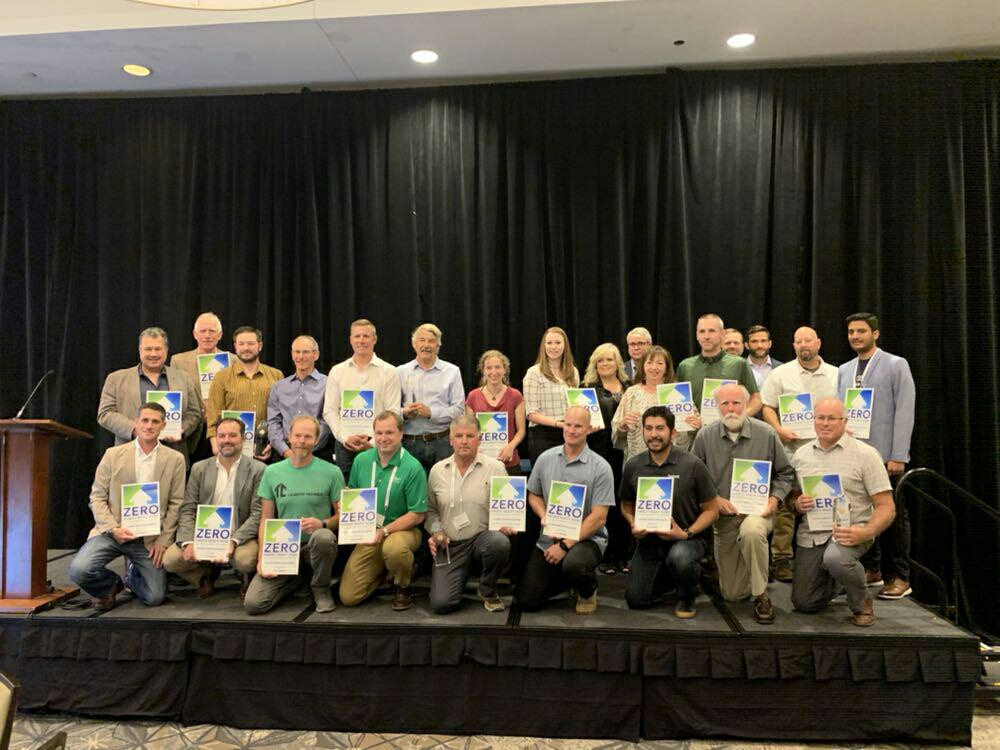Leigha Dickens, Green Building and Sustainability Manager, Deltec Homes
The Energy and Environmental Building Alliance (EEBA) is one of the oldest organizations in the US dedicated to sustainable and energy efficient practices in the built environment. Every year, some of the nation’s most innovative builders gather in their annual Summit to share information and techniques for building high performing homes. This year, Deltec Homes was invited to the EEBA Summit in Denver to receive a Housing Innovation Award, and we are so excited!
Every year, the Department of Energy selects award winners from certified Zero Energy Ready Homes in various categories, from custom homes of various sizes to multifamily projects, spec or production built homes, to affordable homes built through non-profit groups like local Habitats for Humanity. We were so thrilled to be one of the winners in the “custom for buyer under 2500 square feet” category with our most recent Ridgeline project in Mills River. The ceremony was also a great opportunity to meet other high performance builders across the country and learn what they are doing in their own home regions to change the way homes are being built. A focus on air-tight and super insulated construction principles; thoughtful building design to optimize natural comfort, accessibility, and water efficiency; and the use high efficiency systems such as heat pump water heaters, were the common threads I saw in all of our methods. You can see a case study of our winning home on the Department of Energy’s Tour of Zero.
Some other tidbits from the 2019 Housing Innovation Awards:
- Of the 26 winners across the various categories, three of us were from North Carolina. We were, in fact, the most represented state among the winners. It’s great to see our fellow Tar Heels do such innovative work!
- The average (pre-solar) HERS score of all the winning projects is a 45. Over half of the projects, including ours, incorporate a solar PV system. The estimated combined 30-year energy savings from all of the winning projects is $2,332,100!

2019 Housing Innovation Award Winners. You can see virtual tours of all of these homes at the DOE Tour of Zero Website. Photo by Randy Martin.
But the EEBA Summit fun didn’t stop at the awards ceremony. Each day was packed with great presentations and talks on the coming future–and the excitingly innovative present–of high performance building. Colorado’s former Governor Bill Ritter gave the keynote address, sharing some exciting news on the state policy front to de-carbonize our energy grids. Even though federal leadership may be absent, it’s exciting to see how clean energy initiatives created at the state level, sometimes even put in place by voter referenda, have helped put Colorado’s largest utility on track to provide 50% of it’s energy from renewable sources by 2026.
Here are just a few of the many other tidbits that I picked up from the sessions:
- One of the next steps in high performance home design is better analysis of humidity control in hot-humid climates. I picked up some new tools for analyzing more closely when a separate, whole-house humidification system might be necessary in these climates, and learned about some interesting preliminary studies on “smart ventilation” systems that might control the ventilation air based on outdoor humidity or measured indoor air pollution levels.
- Grid-integrated battery storage with systems like the Tesla Power Wall or the Sonnen Batterie were definitely a hot topic, and offer opportunities for revolutionizing our energy systems that reach further than I’d ever thought. There are, right now, demonstration projects going on to try out lots of cool things on a neighborhood scale. Homes equipped with technologies that allow the grid to store excess energy when solar or wind production outpaces demand, and then draw on that energy during periods of higher demand, in people’s heat pump water heaters, home solar batteries, and even their electric cars. Homes equipped with a new generation of smart thermostats that can manage a home’s energy use in ways that allow an entire community to distribute their solar production and battery storage as as isolated and resilient little micro-grid, capable of running on it’s own.
- North Carolina again made the news at the Summit, with a shout out during one session to our own local Blue Horizons Project as an example of a successful grassroots effort to reduce our local utility’s need to build more power plants, using home energy efficiency and demand-reduction initiatives.
They way new home are built is important, perhaps even critical, to the future course of our society’s energy use. According to the US Energy Information Agency, residences currently account for appropriately 20% of equivalent US carbon emissions, and while general shifts to cleaner energy sources in some parts of the grid have brought this number down from 30% in the past decade, there is a still huge and growing housing shortage in this country, and many more homes still need to be built. According to the closing speaker, Denver mayor Michael Hancock, 40% of the housing that will exist in Denver in 2050 will be comprised of homes that haven’t even been built yet. Every home that is built today must be built with energy efficiency, quality systems, resilient systems, and be built ready for net-zero energy and even net-zero water. Otherwise, it’s likely to be obsolete before it’s even finished.
